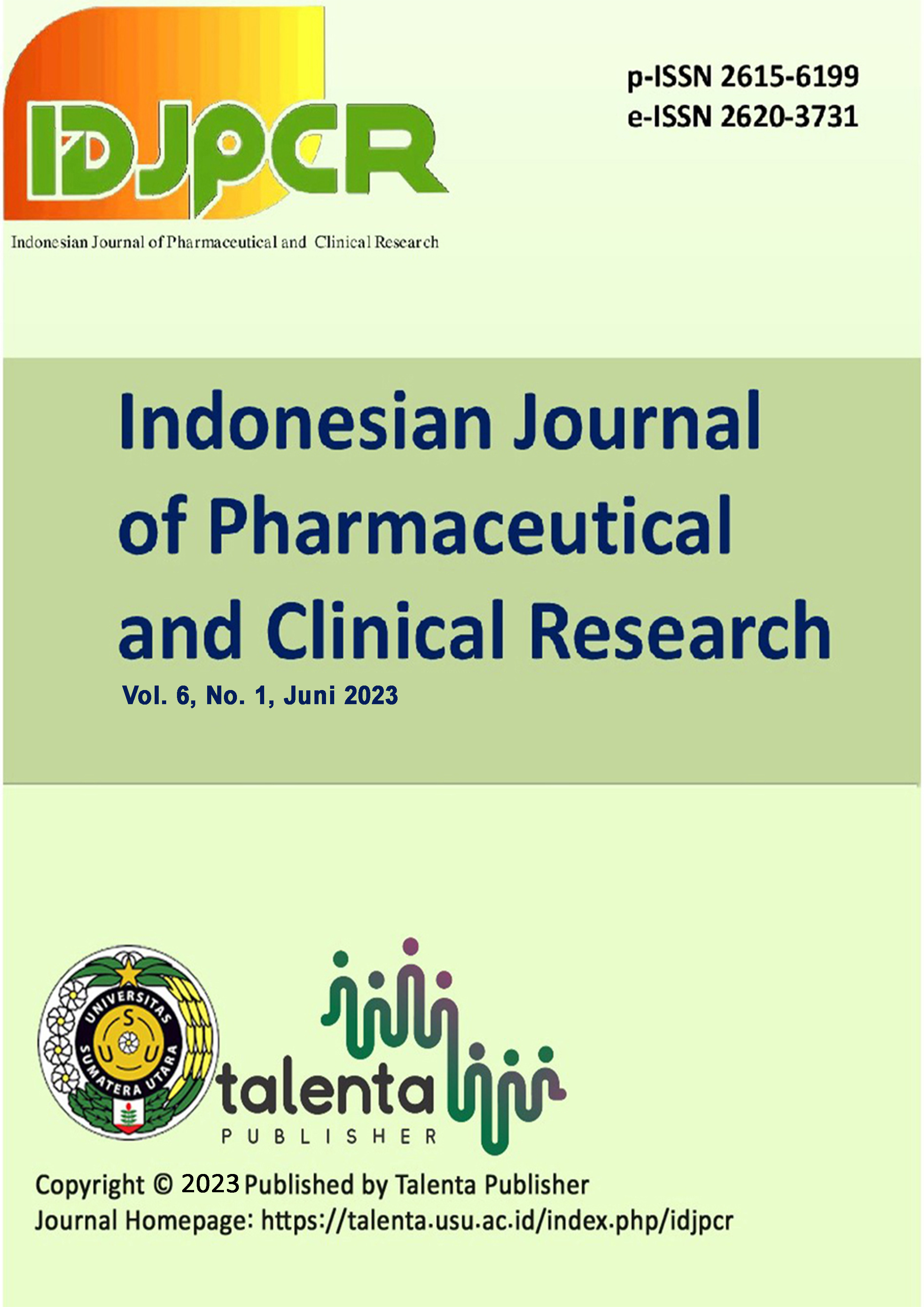Proximate Composition of Anadara granosa and Paphia undulata
DOI:
https://doi.org/10.32734/idjpcr.v6i1.9196Keywords:
Anadara granosa, Paphia undulata, protein, carbohydrates, fat, moisture content, ash content, proximateAbstract
The sea region of Indonesia is particularly abundant in natural resources. One of the economically viable aquatic commodities is shellfish. The public has a high demand for the shellfish Anadara granosa and Paphia undulata. The goal of this study was to ascertain the protein, carbohydrate, fat, water, and ash content of Anadara granosa and Paphia undulata. The study's sample was intentionally drawn from the sea waters off the coast of Belawan, North Sumatera. Following the SNI technique, the proximal level measurement method was used. According to the examination of proximate levels, there is a 10–12% protein content, 0.14–0.15% carbohydrate content, 1% lipid content, 70%–80% water content, and 2% ash content. It can be concluded that, as functional foods, Anadara granosa and Paphia undulata include nutrients that are good for your health.Downloads
References
A. Mahary, “Pemanfaatan tepung cangkang kerang darah (Anadara granosa) sebagai sumber kalsium pada pakan ikan lele (Clarias batrachus sp),†Acta Aquática, vol. 4, no. 2, pp. 63–67, 2017.
Nurjanah, Zulhamsyah, and Kustiyariyah, “Kandungan Mineral dan Proksimat Kerang Darah (Anadara granosa) yang Diambil Dari Kabupaten Boalemo, Gorontalo,†Bul. Teknol. Has. Perikan. , vol. 8, no. 2, pp. 15–24, 2005.
M. R. Usman, R. Nabila, and L. N. Hakiki, “Ekstraksi Kalsium dari Cangkang Kerang Hijau (Perna viridis L.) dan Kerang Batik (Paphia undulata B.) dengan Metode Kalsinasi sebagai Sediaan Effervescent,†Indo. J. Chem. Res., vol. 8, no. 2, pp. 101–107, 2020.
E. D. D. Ginting, I. E. Susetya, P. Patana, and D. Desrita, “Identification of bivalviain Tanjungbalai Waters,North Sumatera Province,†Acta Aquat. Aquat. Sci. J., vol. 4, no. 1, pp. 13–20, 2017.
Y. J. Yee and A. M. Amin, “Physicochemical properties of undulated surf clam (Paphia undulata) hydrolisate as affected by degree of hydrolysis,†Univ. Malaysia Teren. J. Undergrad. Res., vol. 2, no. 3, pp. 15–26, 2020.
I. P. W. Daluningrum, “Penapisan Awal Komponen Bioaktif dari Kerang Darah (Anadara granosa) Sebagai senyawa antibakteri,†Intitute Pertanian Bogor, 2009.
Intan, A. Tanjung, and I. Nurrachmi, “Kerang Darah (Anadara granosa) Abundance in coastal water of Tanjung Balai Asahan North Sumatera,†J. Online Mhs., vol. 1, no. 1, 2014.
C. C. P. R. Rao, S. Casu, and D. I. K. Saheb, “Utilization of blood clam Anadara granosa,†in National Symposium in Research and Development in Marine Fisheries, 1987, pp. 470–473.
P. Donryng, S. Tunkijjanukij, P. Jarayabhand, and S. Poompuang, “Spatial genetic structure of the surf clam Paphia undulata in Thailand waters,†Zooligical Stud., vol. 50, no. 2, pp. 211–219, 2011.
J. W. Nybakken, Biologi Laut, Suatu Pendekatan Ekologis. Jakarta: Gramedia Pustaka Utama, 1992.
A. Abdullah, Nurjanah, T. Hidayat, and R. Chairunisah, “Chemical Characteristics of Meretrix meretrix, Pholas dactylus and Babylonia spirata Meat,†J. Teknol. dan Ind. Pangan, vol. 28, no. 1, pp. 78–84, Jun. 2017.
A. A. Tari, F. K. Duan, and D. Amalo, “Kandungan gizi jenis-jenis kerang yang biasa dikonsumsi masyarakat Nembe Desa Oeseli Kecamatan Rote Barat Daya Kabupaten Rote Ndao NTT,†J. Biotropikal Sains, vol. 15, no. 2, pp. 1–9, 2018.
Reymon, N. S. Daud, and F. Alvianty, “Comparison Of Glucose Levels In Sweet Poultry (Ipomoea batatas Var Ayamurasaki) Using The Luff Schoorl Method,†J. War. Farm., vol. 8, no. 2, pp. 10–19, 2019.
M. A. Nkansah, E. A. Agyei, and F. Opoku, “Mineral and proximate composition of the meat and shell of three snail species,†Heliyon, vol. 7, no. 10, 2021.
S. C. Sweetman, Martindale The Complete Drug Reference, 36th ed. New York: Pharmaceutical Press, 2009.
Pargiyanti, “Optimasi waktu ekstraksi lemak dengan metode soxhlet menggunakan perangkat alat mikro soxhlet,†Indones. J. Lab., vol. 1, no. 2, pp. 29–35, 2019.
S. H. Mohammad and M. S. Yusuf, “Proximate evaluation of some economical seafood as a human diet and as an alternative prospective valuable of fish meal,†J. Fish. Aquat. Sci., vol. 11, no. 1, pp. 12–27, 2016.
S. Syed, R. Ali, M. Ramachandran, S. Kumar Chakma, and M. Asrar, “Proximate composition of commercially important marine fishes and shrimps from the Chennai coast, India,†Int. J. Fish. Aquat. Stud., vol. 5, no. 5, 2017.
D. J. Ooi, S. Iqbal, and M. Ismail, “Proximate composition, nutritional attributes and mineral composition of Peperomia pellucida L. (ketumpangan air) grown in Malaysia,†Molecules, vol. 17, no. 9, pp. 11139–11145, Sep. 2012.
Downloads
Published
How to Cite
Issue
Section
License
Copyright (c) 1970 Indonesian Journal of Pharmaceutical and Clinical Research

This work is licensed under a Creative Commons Attribution-ShareAlike 4.0 International License.
The Authors submitting a manuscript do so on the understanding that if accepted for publication, copyright of the article shall be assigned to Indonesian Journal of Pharmaceutical and Clinical Research (IDJPCR) and Faculty of Pharmacy as well as TALENTA Publisher Universitas Sumatera Utara as publisher of the journal.
Copyright encompasses exclusive rights to reproduce and deliver the article in all form and media. The reproduction of any part of this journal, its storage in databases and its transmission by any form or media, will be allowed only with a written permission from Indonesian Journal of Pharmaceutical and Clinical Research (IDJPCR).
The Copyright Transfer Form can be downloaded here.
The copyright form should be signed originally and sent to the Editorial Office in the form of original mail or scanned document.









